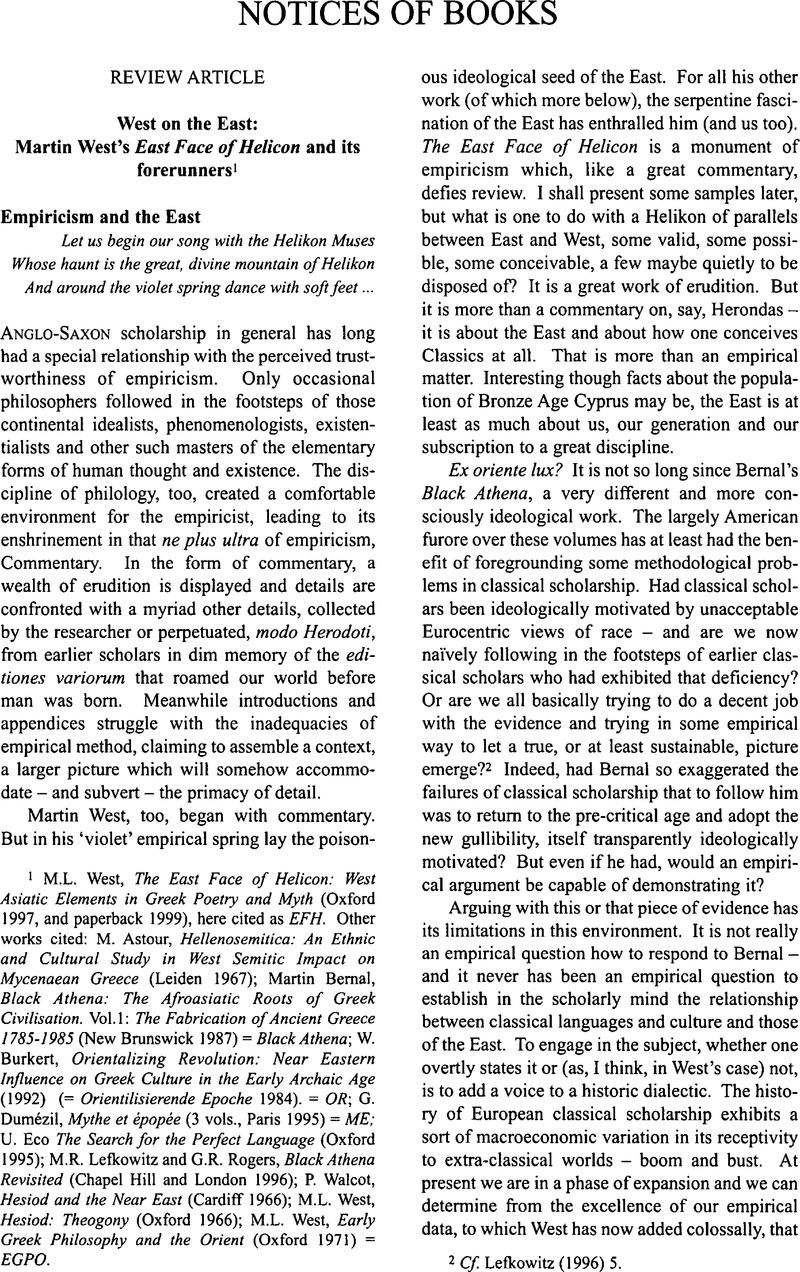Article contents
West on the East: Martin West's East Face of Helicon and its forerunners
Review products
Published online by Cambridge University Press: 23 February 2012
Abstract

- Type
- Notices of Books
- Information
- Copyright
- Copyright © The Society for the Promotion of Hellenic Studies 2001
References
1 West, M.L., The East Face of Helicon: West Asiatic Elements in Greek Poetry and Myth (Oxford 1997Google Scholar, and paperback 1999), here cited as EFH. Other works cited: Astour, M., Hellenosemitica: An Ethnic and Cultural Study in West Semitic Impact on Mycenaean Greece (Leiden 1967)Google Scholar; Bernal, Martin, Black Athena: The Afroasiatic Roots of Greek Civilisation. Vol.1: The Fabrication of Ancient Greece 1785-1985 (New Brunswick 1987)Google Scholar = Black Athena; W. Burkert, Orientalizing Revolution: Near Eastern Influence on Greek Culture in the Early Archaic Age (1992) (= Orientilisierende Epoche 1984). = OR; Dumézil, G., Mythe et épopée (3 vols., Paris 1995)Google Scholar = ME; Eco, U.The Search for the Perfect Language (Oxford 1995)Google Scholar; Lefkowitz, M.R. and Rogers, G.R., Black Athena Revisited (Chapel Hill and London 1996)Google Scholar; Walcot, P., Hesiod and the Near East (Cardiff 1966)Google Scholar; West, M.L., Hesiod: Theogony (Oxford 1966)Google Scholar; West, M.L., Early Greek Philosophy and the Orient (Oxford 1971)Google Scholar = EGPO.
2 Cf. Lefkowitz (1996) 5.
3 Lefkowitz (1996) 9-12, gives a view of some Greek myths of Eastern influence.
4 Eco (1995) 76.
5 Eco (1995) 76-86.
6 Eco (1995) 96, referring to Jan van Gorp (Goropius Becanus) Origines antwerpianae (1569).
7 Eco (1995) 86, referring, e.g., to Meric Casaubon, De quattuor linguis commentatio (1650).
8 Veyne, Paul, Did the Greeks Believe in their Myths? (Eng. trans., Chicago 1988)Google Scholar.
9 Creuzer, Georg Friedrich, Symbolik und Mythologie der alten Völker, besonders der Griechen (3rd edn, Leipzig and Darmstadt 1836)Google Scholar.
10 F. Max Müller, ‘Comparative mythology’ (1856), in, e.g., Müller, F. Max, Chips from a German Workshop (London 1898)Google Scholar, 4.1-154; or Turner, Bryan (ed.), The Early Sociology of religion, Vol. 1: ‘Readings in nineteenth-century theory’ (London 1997) 194–286Google Scholar.
11 Jones, Sir William, address to the Asiatick Society of Bengal, 2 February 1786, in Asiatick Researches, vol.1 (1788)Google Scholar.
12 Astour (1967) xii–xiii puts it down to inadequate knowledge of Semitic materials leading to results that were all too disputable in the late nineteenth century.
13 This is the thesis of Bernal (1987) chs.viii–ix. Both he (373-6) and Astour ((1967) xii) stress the role of Beloch, J., ‘Die Phoeniker am aegeischen Meer’, RhM n.s. 49 (1894) 111–32Google Scholar. Beloch exhibited both racism and, arguably, an unduly critical sense of valid argument.
14 Jankowsky, K.R., The Neogrammarians: A Reevaluation of their Place in the Development of Linguistic Science (The Hague and Paris 1972) 93–7Google Scholar.
15 Burkert, OR 33-40; West, EFH 12-14.
16 West, EFH 59.
17 Bernal (1987) 419-22 on Astour, perhaps underrating the overspill of the exceptional academic hostility to his mentor Cyrus Gordon onto Astour himself.
18 Particularly in the light of the contrast between the Indo-Europeanizing (hittitological) neo-dumézilian Jaan Puhvel (if he will forgive the description) and the orientalizing Walter Burkert.
19 Dubuisson, Daniel, Mythologies du xxe siècle (Lille 1993) 38Google Scholar.
20 J.H. Grisward, preface to Dumézil, ME 31-2; for the languages, see Crystal, D., Cambridge Encyclopedia of Languages (2nd edn, Cambridge 1997) 303, 307Google Scholar.
21 ‘Ultimes descendants des Scythes’, ME 1.19.
22 Cf. ME 1.48, and his ‘La préhistoire indo-iranienne des castes’, Journal Asiatique 216 (1930) 114–24Google Scholar.
23 Notably in ‘Pandavasagan och Mahbharatas mytiska förutsättningar’, Religion och Bibel 6 (1947) 27–39Google Scholar, partly translated in Dumézil's Jupiter, Mars, Quirinus (Paris 1948) 4.37-53 (as noted in ME 1.46). Wikander interpreted the divine parents of the five heroes of the Mahabharata as forming an intelligible structure only in terms of archaic, Vedic thought, thus assisting the process of retrojection which is essential to Dumézil.
24 Dubuisson (1993) 117-19.
25 Belier, W., Decayed Gods: Origin and Development of Georges Dumézil's idéologie ‘tripertite’ (Leiden 1991)CrossRefGoogle Scholar, attempts in painstaking detail to establish the unverifiability of Dumezil's evolving theory.
26 ‘The Hittite version of the Hurrian Kumarbi myths: oriental forerunners of Hesiod’, AJA 52 (1948) 123–34CrossRefGoogle Scholar.
27 Burkert, OR ix.
28 Burkert, Orientalisierende Epoche 14 n.32 (fuller account than in the English translation).
- 4
- Cited by


